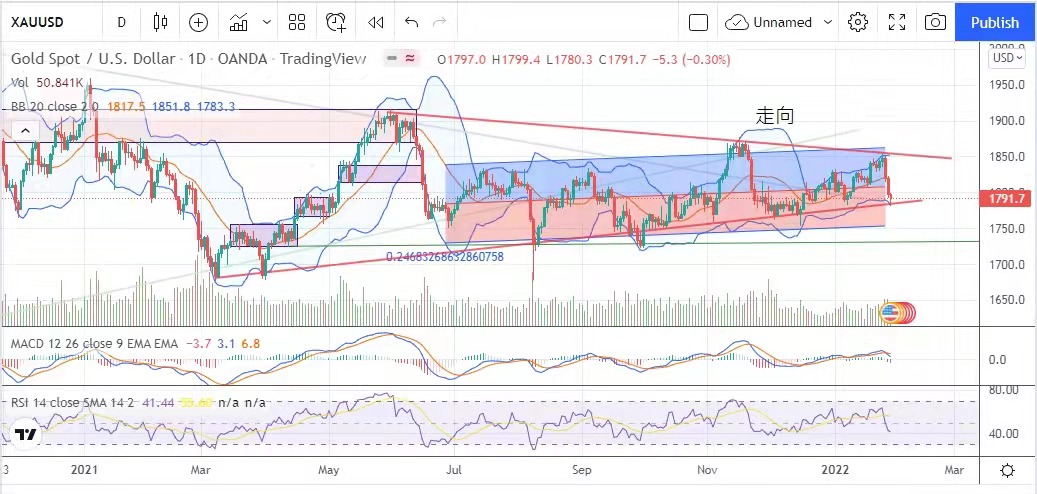Two major events
January 31st
Today's volatility range:
The war crisis in Eastern Europe, which once pushed up the price of gold, slowed down, and Biden of the United States seemed to retreat from the attitude of sending troops to Eastern Europe, causing safe-haven funds to leave the gold market.
In addition, the opportunity cost of holding gold will increase with the increase of interest rate in the United States, and the US dollar index also stole money from the market due to the interest rate increase in March, rising to nearly 97.4 level, which is even more unfavorable to the trend of the gold market.
Today's suggested volatility ranges from $1782 to $1798.
Last week, two major events influenced the global financial market.
First of all, Russia continued to send more troops to Ukraine and its surrounding areas, and conducted offensive and defensive drills, which aroused the concern of NATO allies and sent more ships and military aircraft to the Baltic Sea.
U.S. President Biden is also studying how to send thousands of U.S. troops to the Baltic Sea and consider sending warships and fighters to set out within 72 hours to cope with the changes in the situation in Ukraine.
The risk of war pushed the global stock market atmosphere to pessimism at the beginning of the stock week. Although the situation in Eastern Europe is now turning around, representatives of Russia, Ukraine, France and Germany are meeting on behalf of Paris to seek alternative peaceful solutions.
In addition, Biden of the United States seems to have retreated in his attitude of sending troops to Eastern Europe. US Secretary of Defense Austin said on Friday that Mr. President has made it clear that he does not intend to send combat troops to Ukraine for combat operations.
Instead, the United States will only devote itself to helping Ukraine in terms of security assistance and material provision. The United States did not send troops to Eastern Europe, which greatly eased the chances of conflict between the two camps.
America's plan to stay in Eastern Europe temporarily eased the decline of the stock market; On the other hand, US Federal Reserve Chairman Powell released an eagle last week, indicating that the Federal Reserve decided to start raising interest rates in March.
Federal Reserve Chairman Powell pointed out that the job market is very strong and the Federal Reserve can raise interest rates without damaging the recovery of the labor market. Although Powell said that the rate hike is still undecided. He also said that it is not excluded to raise interest rates at every meeting of the US Federal Open Market Committee.
According to the mildest market estimate, the Federal Reserve will raise interest rates at least four times in 2022, with a total interest rate increase of at least 100 points. The path of interest rate increase is obvious, which weakens the attractiveness of the risk market.
Last week, Hong Kong stocks opened higher and closed lower. Last week, the People's Bank of China lowered the quoted interest rate of China's loan market by 10 pips to 3.8% per annum, and the Hang Seng Index was close to 25,000 pips.
However, the situation in Eastern Europe and the Fed's interest rate hike weakened investors' confidence, and the Hang Seng Index ended its upward trend for five consecutive weeks. In a week, the Hang Seng Index fell by 1,415 pips or 5.7%.
Although the tension in Eastern Europe has slowed down a little, as the eye of the wind in Europe, Russia and NATO allies have been scared all the time without withdrawing their troops, and the three major European stock markets are under pressure.
In a week, Germany's DAX index fell by 1.32%. Paris CAC index rose by 0.82%; Britain's FTSE 100 index rose by 1.17%.
The President of the United States said that he did not want to be stationed in Eastern Europe and become a big winner under the tense situation in Eastern Europe. Coupled with the satisfactory performance of American economic data, in the fourth quarter of 2021, the GDP increased by 6.9% compared with the initial annual rate, which was better than market expectations and the largest increase since 1984.
On the other hand, the US labor data is also good. The Ministry of Labor announced that the number of first-time jobless claims last week was 260,000, a weekly decrease of 30,000, the first decline in the past four weeks.
On the other hand, Apple and Visa, the credit card issuer, reported satisfactory results, and the three major indexes of Wall Street fell and rebounded. In a week, Dow Jones index rose by 1.3%, S&P 500 index rose by 0.8%, and Nasdaq index fell slightly by 0.04%.
Short positions completely dominated the gold market last week. The Federal Reserve decided to raise interest rates in March. Representatives of Russia, Ukraine, France and Germany met on behalf of Paris.
After the meeting, they expressed their support for unconditional compliance with the ceasefire agreement. The tension in eastern Europe is expected to slow down. In addition, the economic data of the United States performed well, and there was too much bad news in the gold market.
The price of gold dropped sharply from the high of $1,853.9, and the lowest once saw $1,780.3. Finally, it closed at $1,791.7. After a week, the price of gold fell by $41.9.
For detailed analysis and operational suggestions, please CLICK the link below to join the group and inquire with the administrator.
https://t.me/mingtakchat
Previous Article Next Article


 Whatsapp
Whatsapp Telegram
Telegram
